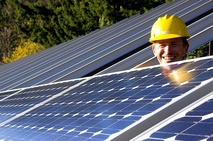Want Solar Power For Your Home?
Speak With a Solar Panel Expert
In one short call, our solar energy consultant will help you find an experienced solar panel installer in your area who can answer your top-of-mind questions:
- how much do solar panels cost?
- what incentives and rebates do I qualify for?
- how long will it take to power my home with solar?
- how much will my power bills go down?
- and more!
This is FREE SERVICE. There is no obligation to purchase anything we discuss.
SOLAR PANEL INSTALLATION: A BUYERS GUIDE

Solar power is an alternative energy source with great economic and environmental advantages.
In case you are contemplating solar power for your house, here's a primer to make you a smarter buyer.
How Solar Power Works
Solar power operates by converting free sun energy into useable electricity. The most typical setup uses photovoltaic tiles to collect the energy inherent in sunshine.
The photovoltaic material includes negative and positive materials, frequently silicon, that respond to sunlight. As the sun hits these cells, the energy dislodges negatively charged ions from the material, which creates a magnetic field that generates an electric current in small collector wires. The wires are joined to an inverter, which converts the energy into a useable AC power source.
The attractiveness of solar power is the fact that, following the initial capital outlay, it's a completely free source of energy. Costs have also improved drastically during the last fifteen years, although historically, the price of solar power was not affordable. Solar panel systems for the house are now a lot more efficient. There's virtually no upkeep and most systems have 50 or 40 year life span.
Free Electricity for Your House?
Going solar is even more appealing now because of recent federal laws passed that provide financial incentives to install solar panels. Homeowners in several states are now able to get a tax rebate for installing solar power in their own residence. In addition to this, over half of all US states now support "net metering", which allows you to sell your surplus generated electricity back to the utility company at exactly the same cost they charge you.
This means you can feed the utility grid with power you generate during the day, then consume grid energy during the nighttime. By doing this swap can drastically reduce, if not completely eliminate, your electricity bill! This could save you $100,000 over the life of your solar system.
Other Advantages
There are several other big reasons to install solar panels in your home, including:
Basic Elements of a Solar Panel Installation
Here are the fundamental elements used in just about any solar panel setup - and their meaning:
1. Photovoltaic Cell. Known as PV, it is a little level cell that carries silicon conversion material under protective glass. It is a solar panel system's fundamental unit. When the sunlight reaches on a PV cell, the silicon material right converts light energy into direct current. One PV cell usually generates 1/2 to 1 volt of electricity.
2. Solar Panel. This really is simply an assortment of solar cells joined in a frame suited to installation.
3. Solar System. This is an engineered group of solar panels that produces enough useful electricity for your house.
4. Orientation. It's important your solar panels are installed with the correct orientation to the sun to optimize their output.
5. Direct Current. Electricity that flows in 1 way only, the exact same kind you see in batteries around your house. Solar cells generate direct current.
6. Alternating Current. Electricity that flows in two ways, in a cycle (normally 60 hertz). Utilities generate aC electricity and is accessible via plugs to all your home appliances. Usually 110 or 220 volts US.
7. Inverter. An electrical device that converts the direct current produced by solar panels into AC electricity which could be utilized in your house or sold back to utilities.
Solar Power: A Do It Yourself Project?
There are two different kinds of solar power technologies - passive and active - but only one can be done as a DIY job.
The first form of solar power generation is active solar power. This uses solar panels to generate electricity. Active solar panels need to be set up by a contractor. State and federal authorities offer tax savings and substantial rebates, but the catch is that these monetary benefits require installation to be performed by an authorized contractor.
The 2nd form of solar power is passive solar, which depends largely on orienting and designing your house in order to make the most of sun that is naturally occurring. Installing passive solar electricity requires the same degree of sophistication as any other building project.
To sum up, definitely use a contractor if solar panels are a part of your system. In the event you're installing a system that is passive, go ahead and install it yourself.
In case you are contemplating solar power for your house, here's a primer to make you a smarter buyer.
How Solar Power Works
Solar power operates by converting free sun energy into useable electricity. The most typical setup uses photovoltaic tiles to collect the energy inherent in sunshine.
The photovoltaic material includes negative and positive materials, frequently silicon, that respond to sunlight. As the sun hits these cells, the energy dislodges negatively charged ions from the material, which creates a magnetic field that generates an electric current in small collector wires. The wires are joined to an inverter, which converts the energy into a useable AC power source.
The attractiveness of solar power is the fact that, following the initial capital outlay, it's a completely free source of energy. Costs have also improved drastically during the last fifteen years, although historically, the price of solar power was not affordable. Solar panel systems for the house are now a lot more efficient. There's virtually no upkeep and most systems have 50 or 40 year life span.
Free Electricity for Your House?
Going solar is even more appealing now because of recent federal laws passed that provide financial incentives to install solar panels. Homeowners in several states are now able to get a tax rebate for installing solar power in their own residence. In addition to this, over half of all US states now support "net metering", which allows you to sell your surplus generated electricity back to the utility company at exactly the same cost they charge you.
This means you can feed the utility grid with power you generate during the day, then consume grid energy during the nighttime. By doing this swap can drastically reduce, if not completely eliminate, your electricity bill! This could save you $100,000 over the life of your solar system.
Other Advantages
There are several other big reasons to install solar panels in your home, including:
- Tax Incentives. You may qualify for government incentives to help cover the price of installing solar panels. What's more, it'll add considerably to your home's value. Green houses are becoming very popular purchases in today's environmentally conscious home market.
- You'll Feel Good About Yourself. Solar is among the cleanest and most environmentally friendly sources of energy you can find.
- Solar panel systems need almost no care. There are zero moving parts, no hoses, no wear and tear. Once their installed, there's almost nothing you need to do to keep them functioning.
- No more power outages! For those who have solar panels with battery storage systems installed, blackouts become a thing of the past.
Basic Elements of a Solar Panel Installation
Here are the fundamental elements used in just about any solar panel setup - and their meaning:
1. Photovoltaic Cell. Known as PV, it is a little level cell that carries silicon conversion material under protective glass. It is a solar panel system's fundamental unit. When the sunlight reaches on a PV cell, the silicon material right converts light energy into direct current. One PV cell usually generates 1/2 to 1 volt of electricity.
2. Solar Panel. This really is simply an assortment of solar cells joined in a frame suited to installation.
3. Solar System. This is an engineered group of solar panels that produces enough useful electricity for your house.
4. Orientation. It's important your solar panels are installed with the correct orientation to the sun to optimize their output.
5. Direct Current. Electricity that flows in 1 way only, the exact same kind you see in batteries around your house. Solar cells generate direct current.
6. Alternating Current. Electricity that flows in two ways, in a cycle (normally 60 hertz). Utilities generate aC electricity and is accessible via plugs to all your home appliances. Usually 110 or 220 volts US.
7. Inverter. An electrical device that converts the direct current produced by solar panels into AC electricity which could be utilized in your house or sold back to utilities.
Solar Power: A Do It Yourself Project?
There are two different kinds of solar power technologies - passive and active - but only one can be done as a DIY job.
The first form of solar power generation is active solar power. This uses solar panels to generate electricity. Active solar panels need to be set up by a contractor. State and federal authorities offer tax savings and substantial rebates, but the catch is that these monetary benefits require installation to be performed by an authorized contractor.
The 2nd form of solar power is passive solar, which depends largely on orienting and designing your house in order to make the most of sun that is naturally occurring. Installing passive solar electricity requires the same degree of sophistication as any other building project.
To sum up, definitely use a contractor if solar panels are a part of your system. In the event you're installing a system that is passive, go ahead and install it yourself.



